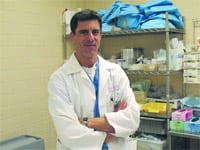Medical Center Expands, Quickens ER Services
HOLYOKE — Holyoke Medical Center is striving to provide improved service for the more than 33,000 patients who visit its Emergency Department each year. It’s one of the busiest Emergency Departments in the region, and like ERs across the state and across the country it is facing increasing patient backlogs due to a variety of factors, most notably an increasing number of people without insurance, who turn to emergency departments as their primary source of healthcare.
The end result is backup of patients in the ER. But Holyoke’s new initiative aims to treat patients with less-severe injuries and illnesses far faster than before — while at the same time prioritizing services in order to continue to ensure that patients with more critical medical needs are seen immediately. While the Emergency Department, as always, is open 24 hours a day, the hospital has expanded its emergency service during some of its busiest hours, Monday through Friday, from 5:30 to 11 p.m. and weekends from 1 to 9:30 p.m. “We’ve been working on this expansion and testing it for several months,” said Finn Scott, director of the hospital’s Emergency Services Department. “And we’re very excited about it. Our aim has been to cut down on waiting times in the ER by separating those people who are very sick from those that are less sick.
“All patients in either category will still be seen by our regular Emergency Department doctors, nurses and technicians,” he continued. “But by separating the patients into different levels of need we can speed up the process significantly.”
Asked for examples of those with minor injuries, Finn pointed to those coming in with sprains and strains, sore throats, fevers, bug bites, minor burns, or similar types of illnesses or injuries. In the past, those patients would come to the emergency department and see a triage nurse, who would prioritize the patient based on the severity of the ailment.
As one would expect, those with urgent needs, such as chest pain, would be put at the front of the line so they could be seen immediately. That would often cause those with minor injuries or illnesses to have to wait several hours to receive treatment. But now, under the new system, an entirely different section of the Emergency Department with a separate waiting area has been set up specifically for patients in need of minor care, and they’ll be taken there immediately after seeing the triage nurse.
“Our goal is to have emergency patients in need of minor care treated and discharged within 90 minutes,” Scott said. “This will be a major improvement over what people have sometimes had to deal with in the past.”
Scott said that the service will not only help patients but will provide an enhanced atmosphere for staff as well, who are already seeing a significant reduction in congestion and back-ups in the Emergency Department.

